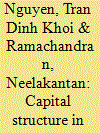|
|
|
Sort Order |
|
|
|
Items / Page
|
|
|
|
|
|
|
| Srl | Item |
| 1 |
ID:
138104


|
|
|
|
|
| Summary/Abstract |
This paper uses a panel data-fixed effect approach and data collected from Chinese public manufacturing firms between 1999 and 2011 to investigate the impacts of business life cycle stages on capital structure. We find that cash flow patterns capture more information on business life cycle stages than firm age and have a stronger impact on capital structure decision-making. We also find that the adjustment speed of capital structure varies significantly across life cycle stages and that non-sequential transitions over life cycle stages play an important role in the determination of capital structure. Our study indicates that it is important for policy-makers to ensure that products and financial markets are well-balanced.
|
|
|
|
|
|
|
|
|
|
|
|
|
|
|
|
| 2 |
ID:
073333


|
|
|
|
|
| Publication |
2006.
|
| Summary/Abstract |
The objective of this article is to identify the determinants influencing the capital structure of small and medium-sized enterprises (SMEs) in Vietnam. Empirical results show that SMEs employ mostly short-term liabilities to finance their operations. A firms ownership also affects the way a SME finances its operations. The capital structure of SMEs in Vietnam is positively related to growth, business risk, firm size, networking, and relationships with banks; but negatively related to tangibility. Profitability seems to have no significant impact on the capital structure of Vietnamese SMEs. The strong impact of such determinants as firm ownership, firm size, relationships with banks, and networking reflects the asymmetric features of the fund mobilization process in a transitional economy like that of Vietnam.
|
|
|
|
|
|
|
|
|
|
|
|
|
|
|
|
| 3 |
ID:
069042


|
|
|
| 4 |
ID:
092533


|
|
|
|
|
| Publication |
2009.
|
| Summary/Abstract |
We study the determinants of capital structure for 650 Chinese publicly listed companies over the period from 1999 to 2004. We posit that a firm's decision on capital structure is inherently dynamic, and estimate the resulting dynamic capital structure model. The main findings of the paper are as follows: (i) Chinese firms adjust toward an equilibrium level of debt ratio in a given year at a very slow rate; (ii) firm size, tangibility and state shareholdings are positively associated with firm's leverage ratio, while profitability, non-debt tax shields, growth and volatility are negatively related to firm's leverage ratio; (iii) lagged profitability has a negligibly small and positive impact on firm's leverage ratio; (iv) for a firm experiencing a large reduction in its leverage ratio only about 11% of the discrepancy between its desired and actual leverage level is eliminated within a year (compared to more than 18% for full firm sample); (v) extending the basic model to allow for both the target level and the speed of adjustment to be endogenously determined, we find that Chinese firms tend to adjust faster if they are farther away from the equilibrium leverage level; and lastly (vi) extending the sample period to cover the earlier periods starting from 1993, when the Chinese stock markets were first developed, results in a slower speed of adjustment for firms in the below target sample.
|
|
|
|
|
|
|
|
|
|
|
|
|
|
|
|
| 5 |
ID:
170091


|
|
|
|
|
| Summary/Abstract |
In this paper, we use China’s value-added tax (VAT) reform in 2007, which was aimed to encourage fixed investment purchasing, as a natural experiment to explore the effect on firm financial leverage. Results show an expansion in firm balance sheet after the reform, manifested by greater liabilities (long-term, short-term and total liability) and asset. Moreover, in terms of the ratio to asset, it’s found that long-term liability rose while the short-term liability dropped, and as a net effect, the total asset-liability ratio declined as the latter effect dominated. To theoretically explain the observed patterns, three mechanisms are highlighted, “income effect”, “maturity-match effect” and “market disciplining effect”, where income effect corresponds to a proportional expansion of balance sheet while the latter two effects alter the composition of firm leverage.
|
|
|
|
|
|
|
|
|
|
|
|
|
|
|
|
| 6 |
ID:
150707


|
|
|
|
|
| Summary/Abstract |
The new century has witnessed phenomenal worldwide growth in renewable energy investments. China has been especially remarkable, surpassing both the US and the EU in 2013. Some recent facts, however, have raised the question of whether exuberant investment in China’s renewable energy sector is rational. This paper aims to contribute to the literature and to the debate in two ways. First, it tests the over-investment hypothesis based on the main stream finance methodology; second, it analyzes the role of capital structure in the performance of China's renewable energy firms. Empirical results show that overinvestment in the renewable energy sector exists. The problem is more significant in the biomass and wind sector. Capital structure is found to be more important to downstream firms, indicating that policy makers may provide support that enables these firms to finance their investments through corporate bonds, commercial credit, or long-terms debts.
|
|
|
|
|
|
|
|
|
|
|
|
|
|
|
|
| 7 |
ID:
170221


|
|
|
|
|
| Summary/Abstract |
This paper analyzes the impacting factors of the capital structure of military listed companies in China, based on the 2001–2015 panel data of 104 Chinese listed companies, and we explore practical approaches for Chinese private capital entering the military enterprises, given the strategy of the civil–military integration. We show that: (1) state-owned shares and domestic legal person shares negatively impact the capital structure of military enterprises and mainly show in non-current liability. While the foreign legal person shares and the shareholding ratio of executives and managers have no significant impact. (2) As for the financial indicators, coefficients of firm size, asset tangibility, and growth are positive, while those of profitability, non-debt tax shield, and growth opportunity are negative. (3) Given the civil–military integration strategy, equity financing imposes a negative impact on the capital structure of military enterprises. The negative impact increases, with the increase in military enterprises’ profitability, business risk, and growth opportunities, and with the decrease in military enterprises’ growth and firm size. (4) The negative impacts of equity financing are significant, if debt ratios of the military enterprises are too small or too large. While the state-owned shares only have significant negative impact on military enterprises whose debt ratios are too small. As a conclusion, we suggest private capital to prioritize the corporate bonds or short-term borrowing to enter the military industry, and choose smaller or medium-sized military enterprises with more growth opportunities and lower business risks.
|
|
|
|
|
|
|
|
|
|
|
|
|
|
|
|
| 8 |
ID:
147446


|
|
|
|
|
| Summary/Abstract |
While public–private partnerships (PPPs) have become an increasingly popular approach in both developed and developing countries, very little is known about whether or not PPPs are more efficient than pure-public or pure-private modes. Building on some recent work studying PPP issues this paper improves the understanding of public–private capital structures, provides some theoretical considerations as well as empirical evidence that private participation affects PPPs cost through the knowledge-transfer effect and the cost-increase effect, and demonstrates a U-shaped relationship between the project costs and private shares. Empirical analysis also finds that the private shares in China's infrastructure PPPs are excessive, and BOT (build, operate, and transfer) projects, compared to other PPP types, are not efficient in China.
|
|
|
|
|
|
|
|
|
|
|
|
|
|
|
|
| 9 |
ID:
096238


|
|
|
|
|
| Publication |
2010.
|
| Summary/Abstract |
We use the panel threshold regression model to examine the capital structure decision of Taiwanese firms investing in China for the period 2000 to 2006. Results of the entire sample reveal that a firm's debt ratio decreases as foreign direct investments (FDIs) in China increase when firms have low FDIs but becomes insignificant when firms have high FDIs in China. When we examine Taiwanese firms having FDIs in China and in other developed countries, their debt ratios increase as FDIs in China increase. In contrast, their debt ratios decline when Taiwanese firms with FDIs in China and in other developing countries are considered. Our results imply that the capital structure of Taiwanese firms depends on the overall portfolio risk of their investments.
|
|
|
|
|
|
|
|
|
|
|
|
|
|
|
|
|
|
|
|
|